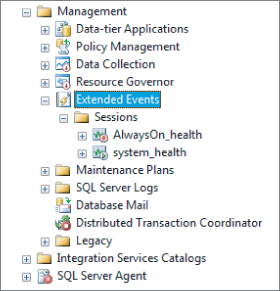The Extended Events Profiler
The biggest change to Extended Events in SQL Server 2012 is the new user interface to create and modify Extended Events sessions. Extended Events now has a folder under the Management folder in Object Explorer (see Figure 40.2). From this folder you can create a new Extended Event session, modify existing sessions, view Target data for existing sessions, and Watch Live Data. If you choose the last option you're presented with an interface similar to the SQL Profiler you're familiar with, but one that captures Extended Events information as it is processed.
Figure 40.2 You can view the new Extended Events folder in Object Explorer. Users can now create and modify Event Sessions graphically using SQL Server Management Studio.

Get Microsoft SQL Server 2012 Bible now with the O’Reilly learning platform.
O’Reilly members experience books, live events, courses curated by job role, and more from O’Reilly and nearly 200 top publishers.

